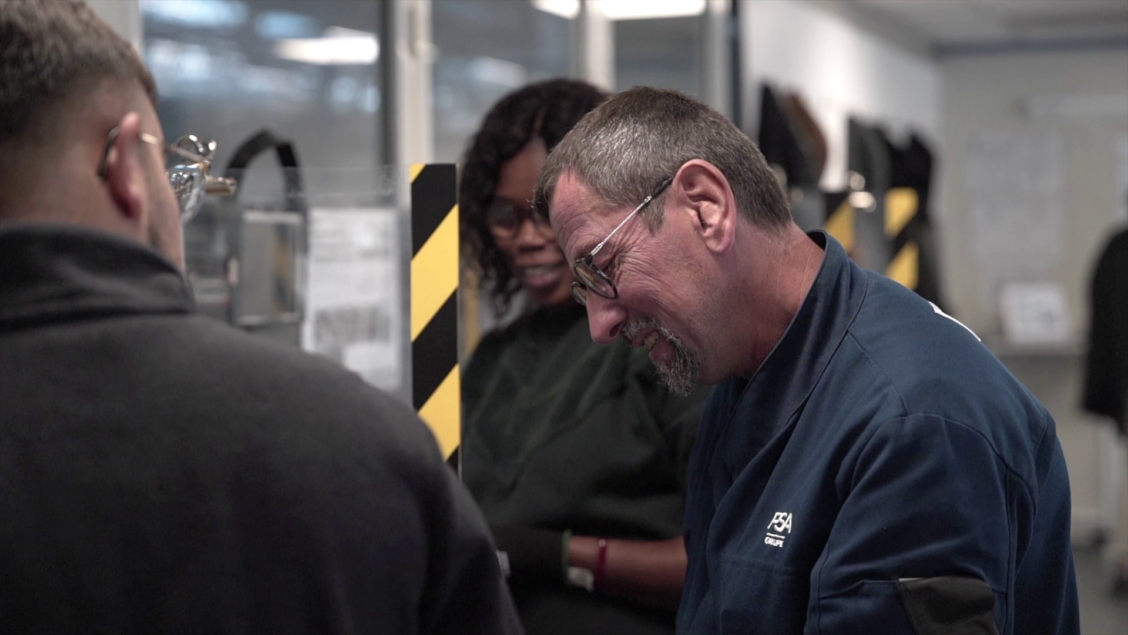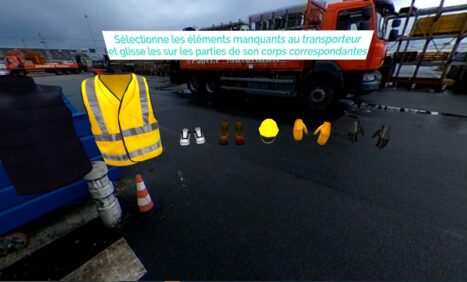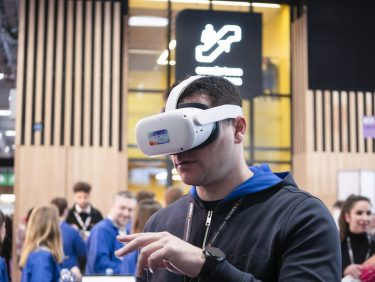Accelerating the skills development and operational performance of new operators
To achieve its ambitious industrial goals (0 defects and production costs divided by 2), Stellantis decided to digitize its 150 workstation training using virtual reality.
As a matter of fact, their training sessions are composed of a theoretical part based on JES (Job Element Sheets). These are Excel files technically describing the successive operations. However, their teams wanted to make it more immersive to facilitate the operators’ skills development and simplify the updating of the JES content.

Faster empowerment, easier standardization!
Thanks to Uptale, their teams easily and autonomously created Virtual JIT (Job Instruction Training) modules to meet various objectives: accelerate the training and qualification time of the operators, when they arrive or during the rebalancing, or optimize the time of the team leader in charge of training and production.
Furthermore, to quickly reproduce the training in the platform, they used templates. These are a set of reusable and customizable interactions. And in just a few hours, Stellantis rapidly digitize, translate, and roll out its training to all of its worldwide locations.
« At Sochaux, we have witnessed a 20% reduction in training time to obtain a certification. We save time on theoretical training and speed up the convergence on final certification throughout the training process. »
- 5 sites are continuously training their operators in VR
- 5 days to 5 hours to create a complete training on a workstation
- To be properly qualified, it only takes 5 to 6 days of training instead of 10
— Industrial Performance Expert at Stellantis

What is workstation training?
It is about making an operator autonomous (“qualified”) to work and ensure the proper function of the production line.
- To guarantee the work expected at the station in transforming the vehicle without quality defects.
- To keep the production line functioning unhindered by a lack of rhythm or lack of expertise.
The qualification, a major challenge at Stellantis
Theoretical and practical training are both fundamental for the qualification of an operator.
Today, according to Stellantis, it takes about 400 cycles for an operator to master all the operations in full autonomy, with a short cycle time (1min) and a successful result.
Thanks to virtual reality, the operator will be able to repeat the experience as many times as necessary until he masters all the steps. Finally, he will have to pass a test before going on to the practical training.
Easy to use, a driver for accelerating skills development
Stellantis chose to digitize its theoretical training, based on Excel files.
Therefore, it was mandatory to use an easy-to-use platform to easily transcribe the content of these files. In just a few clicks, they were able to create their immersive training and deploy them in their facilities, in France and around the world.
Thanks to Uptale, Stellantis reduced the time needed to create a complete training course on a workstation from 5 days to only 5 hours!
ROI with Uptale
÷2
training and certification time
÷2
operators' quality defects
÷2
the number of line stops that could occur
Session Q&A
Are the modules integrated into the LMS (Learning Management System) to keep track of the training for each learner?
It is important to ensure the tracking of the production system. Hence, the learning data is stored by default in Uptale and, if there is an existing integration, in the company’s LMS.
– Marc, Stellantis
There is an existing integration between Stellantis and Uptale thanks to SSO (Single Sign-on). In other words, it is the learners’ traditional professional logins, which they would use daily in their HR platform, LMS, work tools…
Moreover, when integration is made between Uptale and an LMS, which is already the case in other companies, the necessary and intelligible information is aggregated by the LMS. For example, this has already been done for Cornerstone, CrossKnowledge, 360 Learning, etc. As a result, the learning data collected during the training session is recorded and made available to the trainers, by default in Uptale.
On the other hand, regarding the digital identity of operators, some of them, such as temporary workers, do not necessarily have login details within the company (e-mail). Thus, to overcome this, we have systems where learners can register themselves (name, first name, email, work site…).
– Aurélie, Uptale
5 hours to create a training, but how long to create the templates?
This first phase, from the moment we started to the moment we finalized the templates took 3 months.
But what took the most time was not the creation in Uptale, it was the pedagogical conception. That is, creating a template that can be applied to all workstations and that faithfully reproduces traditional training. Indeed, it must save training time and module production time.
On the other hand, a template can be quickly created if it addresses subjects that we are used to dealing with (e.g.: site visits, training on health & safety risks, etc.). With Stellantis, it was a bit different, because we had to create a custom template and understand in depth how the certification process was done to make it as accurate as possible.
– Aurélie, Uptale
The assembly instructions evolve quite often! Is there an automatic system for updates (depending on their complexity)?
Everything goes through the database. It is essential to update the balancing, i.e. the definition of operations on a given station within the cycle time. Moreover, the connection with the Uptale platform retrieves the latest version of the data and updates the training module.
Then, regarding the images and 360° photos, if there is a change of operation on the workstation, we will have to redo them in theory. However, the 360° shot can be done in 1 minute, just like the cycle time in the factory (by finding the right car and the right person at the right station with the right gestures…). Even better, Uptale can create the training module automatically thanks to a standardized structure, based on this data.
– Lionel et Marc, Stellantis
Shooting is not the most time-consuming thing: you set up the camera and record. It’s the pedagogical engineering prior to getting a qualitative and useful module.
– Jawed, Uptale
How does your translation process work? How many people are involved?
The Uptale platform natively includes a feature to translate all the texts and audio in the module into 40 different languages.
For example, for the first modules we made with Stellantis, we needed to translate into Spanish, Italian, English and also Fārsi. Then, once the module was translated, a new tab to review and check the translation opened. So, you can do an Excel export of the translation, have someone check and make changes directly in this file and import it into the platform. Uptale will then automatically update the translations.
– Aurélie, Uptale
Furthermore, the most time-consuming part of the process is to check that the translation result is accurate. You have to proofread the translation to make sure there are no errors in the automatic translation.
– Lionel, Stellantis
When you deploy an experience to another site, do you redo the videos on the new site?
Yes. Yes. However, to save time, we could use the same module if we use an identical car, so that the cycle time on an equivalent station is similar from one facility to the other… But in addition to these conditions, there is the educational aspect of immersion and preparation for the work environment. If we represent a production line from a specific site while training on a completely different site, the learner will feel distraught once the theoretical training is over.
In my opinion, working in an already familiar environment is an important element because it will give the trainee confidence. So while the 360 video capture is not the most difficult thing to do, we have redone it on each site.
– Lionel, Stellantis
Nevertheless, we had a kitting module that could be applied to almost all the sites. This was because the methodology was quite common among the Stellantis sites.
– Aurélie, Uptale
Can the learner trigger a certification at the end of the training?
Theoretical training is meant to facilitate practical training. The sum of the two is required to successfully complete the training.
What will characterize the operator’s certification is when the operator masters the tasks autonomously, at the right pace, and with a successful outcome. Today, it is considered that 400 cycles are required, i.e. 400 equivalent cars.
In our project, it is a question of doing a theoretical check and not a practical one. Thus, we are still far from determining whether the operator is qualified.
However, this phase will be taken into account for the overall certification. ecause at the end of the theoretical training, there is a test that must be validated before moving on to the next stage. The operator must repeat the test as many times as necessary until he masters all the phases in chronological order, the key points, etc.
– Lionel, Stellantis
Depending on what has been defined, there is a system of success and module completion. We also have a certification system at the end of the module. But in the case of Stellantis, we have not activated it, since this is not the way to validate the certification.
– Aurélie, Uptale
Do you have dedicated people to create Uptale capsules?
At Stellantis, there is a bridge between the manufacturing team and the pedagogical team to build and deliver the training.
The Team Leader, the manufacturer and expert in the production of their zone (7 stations), is also responsible for the training module. Indeed, they know perfectly the know-how of the workstations and can check if the training is well conceived. Therefore, the objective is to rely on them but to reduce their workload.
Then, the training will be carried out by the pedagogical team, outside the production line.
– Lionel et Marc, Stellantis
To get started with VR, how many headsets and equipment do you need to consider, for example, on a site?
Nowadays, we consider that a kit of 6 VR headsets and a 360 camera is enough to be autonomous. You can do it with less, or with more, but I think it’s the right balance to be autonomous in a multi-station training facility at Stellantis. Plus, we can organize ourselves if there are more than six people.
With this setup and in less than an hour, the trainee operator can successfully complete the module.
– Lionel, Stellantis
Moreover, during the training sessions, the learners are in groups of approximately 10 people. So 6 headsets are enough.
– Aurélie, Uptale
Do you have a trainer attending the training session?
Yes, the training is conducted by the pedagogical team, including a trainer, outside the production line. And the truth is, we can imagine anything. We can also do self-training, because there are voices that guide us, for example.
However, in our case, we want a trainer to manage 6 training sessions at the same time He makes sure that the learner has properly installed the headset and that the module is working well… We are also working on a remote control, where the trainer would have real-time video feedback to see the evolution of the 6 learners at the same time. This will help to detect problems and assist the learners if necessary.
– Lionel et Marc, Stellantis
Indeed, the trainer has a pivotal role in the facilitation of immersive training sessions. He is the one to give instructions, help put on the headsets or debrief with the learners.
Today, we include a tablet in the VR headsets kit to control the module in the headsets. The later objective is to make it the central management tool for the trainer of a session: to follow the progress, to help without having to remove the helmets of the learners…
– Aurélie, Uptale
Do you plan to deploy it on PC at the same time? (in addition to the headsets)
We don’t necessarily have to use a headset to do these training sessions. They work very well on screens and computers… However, for immersion, it is more appropriate to use a virtual reality headset. The operator is immersed in the workstation and can turn left and right as desired.
– Lionel, Stellantis
Can we only use Uptale on very structured procedures?
For the Virtual JIT project, yes. The goal is to show the learner the best practices for qualification. Therefore, everything must be in accordance with the training standard. Similarly, when building the media (videos, photos, etc.), precautions were taken to show only the right gestures.
– Marc, Stellantis
What is the format of the Uptale modules?
It depends on the training. But the maximum duration should be about 15-20 minutes.
– Marc, Stellantis




